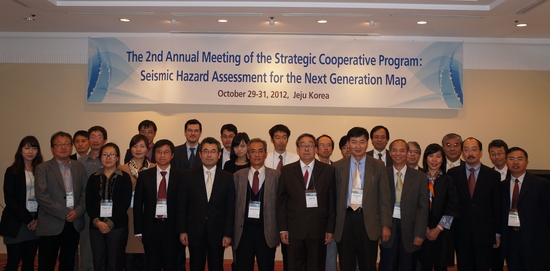The 2nd Annual Meeting

The 2nd Annual Meeting of the Strategic Cooperative Program:
Seismic Hazard Assessment for the Next Generation Map, October 29-31, 2012, Jeju, Korea
Second annual meeting of the strategic project was hosted in Jeju Korea Oct 29-31, 2012, where in parallel with the East-Asia Earthquake Seminar 2012. We were so pleased to have special lectures from Professors Hiroo Kanamori, Christopher Newhall. Participants in our meeting included 13 researchers from Japan, 8 from China, 15 from Korea and two invited guests from Taiwan and one from Italy. Dr. Myung-Soon JUN had welcome words and over 26 presentations presented from the fields of Input for Seismic Hazard, Attenuation on Seismic Hazard, PSHA, Active fault and Site amplification on Seismic hazard.
On panel discussions, methodologies of simulation-based PSHA and deterministic seismic hazard assessment (DSHA), issues of the low annual frequency of exceedance (very long return-period) of active faults, collaboration between geologist & seismologist on the active fault study, gaps between the scientific fields and engineering requirements, importance of public education and communications were discussed. On the future plan, the 3rd Annual Meeting of the Seismic Hazard Assessment for the Next Generation Map will be hold in Japan next year.
Please note that presentations appeared are through courtesy of the presenters for "PERSONAL USE ONLY" and the copyrights fully belong to the authors. If you want to use any figures, texts and pictures in the presentation materials in any other purposes, please be sure to contact with the authors to get permission (if you need their contact information, please let us know).
Chinese Seismic Hazard Study
-
Scenario earthquake – a link of probabilistic and deterministic SHAs
![[Get PDF] [Get PDF]](image/meeting/2nd/29_01_China.jpg)
Tao Xiaxin
PDF / 2.0MB -
New Seismic Zonation Map of China and the Case Study in Gansu Province
![[Get PDF] [Get PDF]](image/meeting/2nd/29_02_China.jpg)
Li Xiaojun
PDF / 5.0MB -
Tectonic mechanism of the great Wenchuan earthquake
![[Get PDF] [Get PDF]](image/meeting/2nd/29_03_China.jpg)
Zhao Jisheng
PDF / 1.1MB
Input for Seismic Hazard
-
Should worst-case scenario of Mega-earthquake be considered in East Asian region, the lessons learnt from recently destructive earthquakes
![[Get PDF] [Get PDF]](image/meeting/2nd/30_01_Japan.jpg)
Ken Xiansheng Hao
PDF / 4.1MB -
Input data for Seismic Hazard in Korea
![[Get PDF] [Get PDF]](image/meeting/2nd/30_02_Korea.jpg)
Myung-Soon Jun
PDF / 2.3MB -
Possible mega-thrust earthquake along the Ryukyu trench: event the historical records can't tell
![[Get PDF] [Get PDF]](image/meeting/2nd/30_03_Taiwan.jpg)
Kuo-Fong Ma
PDF / 5.9MB -
Cyclic Pattern of Nankai Trough Earthquakes and the Task in its Modeling, - Primary Uncertainty in Earthquake Hazard/Risk Model -
![[Get PDF] [Get PDF]](image/meeting/2nd/30_04_Japan.jpg)
Toshihiro Yamada
PDF / 758KB
Attenuation on Seismic Hazard
-
A new ground motion prediction equation for Japan based on the 2011 Tohoku-oki earthquake records
![[Get PDF] [Get PDF]](image/meeting/2nd/30_05_Japan.jpg)
Nobuyuki Morikawa
PDF / 2.4MB -
Practice on Estimating Beta & Mmax
![[Get PDF] [Get PDF]](image/meeting/2nd/30_06_Korea.jpg)
Myung-Hyun Noh
PDF / 1.3MB -
Next Generation Attenuation Model Project in Japan and Recent Progress
![[Not available] [Not available]](image/meeting/noimg.png)
Hongjun Si
-
Construction of the detail 3D velocity structure models in Japan
![[Get PDF] [Get PDF]](image/meeting/2nd/30_08_Japan.jpg)
Hisanori Matuyama
PDF / 17MB
PSHA
-
Some considerations towards improvement of the National Seismic Hazard Maps for Japan after the Great Tohoku Earthquake
![[Get PDF] [Get PDF]](image/meeting/2nd/30_09_Japan.jpg)
Hiroyuki Fujiwara
PDF / 5.9MB -
Improvement of Seismic Hazard Map in Korea
![[Not available] [Not available]](image/meeting/noimg.png)
Jeong-Soo Jeon
-
International collaboration in the hazard component of the Global Earthquake Model
![[Get PDF] [Get PDF]](image/meeting/2nd/30_11_GEM.jpg)
Marco Pagani
PDF / 2.2MB
Active Fault & Site Amplification on Seismic Hazard
-
Are there active faults in Korean Peninsula
![[Not available] [Not available]](image/meeting/noimg.png)
Sung-Ja Choi
-
The utility of earthquake hazard information in Japanese companies
![[Not available] [Not available]](image/meeting/noimg.png)
Takayuki Hayashi
-
Discussion on Seismic Site Response Characteristics in Korea
![[Get PDF] [Get PDF]](image/meeting/2nd/30_14_Korea.jpg)
Chang-Guk Sun
PDF / 3.6MB -
The development of K-SEIS(Korea Speedy Earthquake Information System including EEW(Earthquake Early Warning)
![[Get PDF] [Get PDF]](image/meeting/2nd/30_15_Korea.jpg)
Jung-Ho Park
PDF / 5.9MB -
Site Amplification Study – Case of the Taipei Basin
![[Get PDF] [Get PDF]](image/meeting/2nd/30_16_Taiwan.jpg)
Kuo-Liang Wen
PDF / 4.0MB -
Mobile Applications using J-SHIS API
![[Get PDF] [Get PDF]](image/meeting/2nd/30_17_Japan.jpg)
Shinichi Kawai
PDF / 2.9MB -
A detection method for giant earthquake based on counting a number of seismic intensity observation stations
![[Get PDF] [Get PDF]](image/meeting/2nd/30_18_Japan.jpg)
Hiromitsu Nakamura
PDF / 1.1MB


![[Get image] [Get image]](image/meeting/2nd/photo1_thumb.jpg)
![[Get image] [Get image]](image/meeting/2nd/photo2_thumb.jpg)
![[Get image] [Get image]](image/meeting/2nd/photo3_thumb.jpg)
![[Get image] [Get image]](image/meeting/2nd/photo4_thumb.jpg)
![[Get image] [Get image]](image/meeting/2nd/photo5_thumb.jpg)
![[Get image] [Get image]](image/meeting/2nd/photo6_thumb.jpg)
![[Get image] [Get image]](image/meeting/2nd/photo7_thumb.jpg)
![[Get image] [Get image]](image/meeting/2nd/photo8_thumb.jpg)